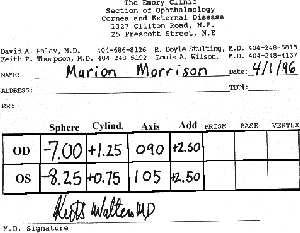20/20 Vision
| Visual acuity is usually
measured with a Snellen chart. The Snellen chart displays
letters of progressively smaller size. "Normal" vision is
20/20. This means that the test subject sees the same line
of letters at 20 feet that a normal person sees at 20 feet.
20/40 vision means that the test subject see as 20 feet what
a normal person sees at 40 feet. Another way of saying this
is that a person with 20/40 vision has vision that is only
half as good as normal - or, objects must be at half the
normal distance for him to see them. A person with 20/20 vision is able to read letters 1/10th as large as someone with 20/200 vision. However, 20/15 vision is better than 20/20. A person with 20/15 vision can see objects at 20 feet that a person with 20/20 vision can only see at 15 feet.
To appreciate how the eye
works, imagine yourself as a beam of light reflected from a
100-foot tree into the eye of a living person. You are the
image of the tree, traveling at the speed of light and about
to enter an obstacle course on your way to the brain of the
observer.
Your Prescription: The
refractive error of the eye can be expressed in numeric
terms. The power of the lenses necessary to correct your
vision is measured in units called diopters (see below). The
first number designates the amount of myopia (minus numbers)
or hyperopia (plus numbers). The second number (if present),
indicates the amount of astigmatism.
What is a Diopter? A diopter is a unit of measurement of the refractive error. It may be a negative number (myopia, nearsightedness), or a positive number (hyperopia, farsightedness). A -1.00 diopter myope is able to see objects at 1 meter clearly. A -2.00 diopter myope is able to see objects at a ½ meter clearly. The greater the myopia, the strength of the lens in diopters needed to correct the refractive error, and the closer an object must be to be viewed clearly.
|


 The
third number shows the axis of the astigmatism. Depending on
the sign of the second number, the axis indicates the
orientation of the steepest or flattest meridian of the
cornea. The fourth number is the "add", or the amount of
magnification needed to give clear vision at near. If this
number is present, bifocals have been prescribed to correct
presbyopia.
The
third number shows the axis of the astigmatism. Depending on
the sign of the second number, the axis indicates the
orientation of the steepest or flattest meridian of the
cornea. The fourth number is the "add", or the amount of
magnification needed to give clear vision at near. If this
number is present, bifocals have been prescribed to correct
presbyopia.